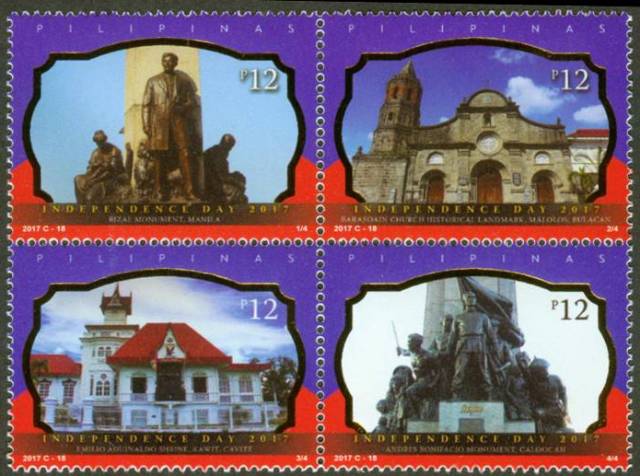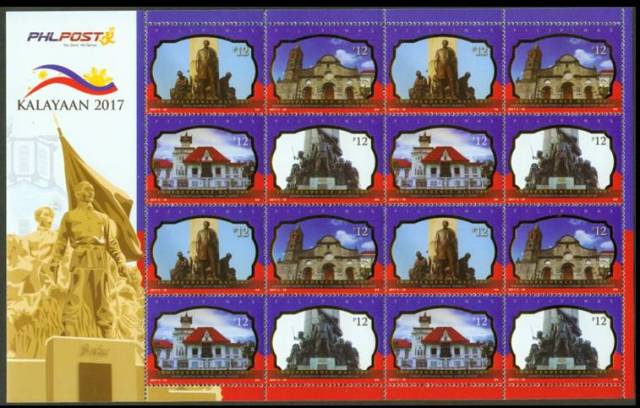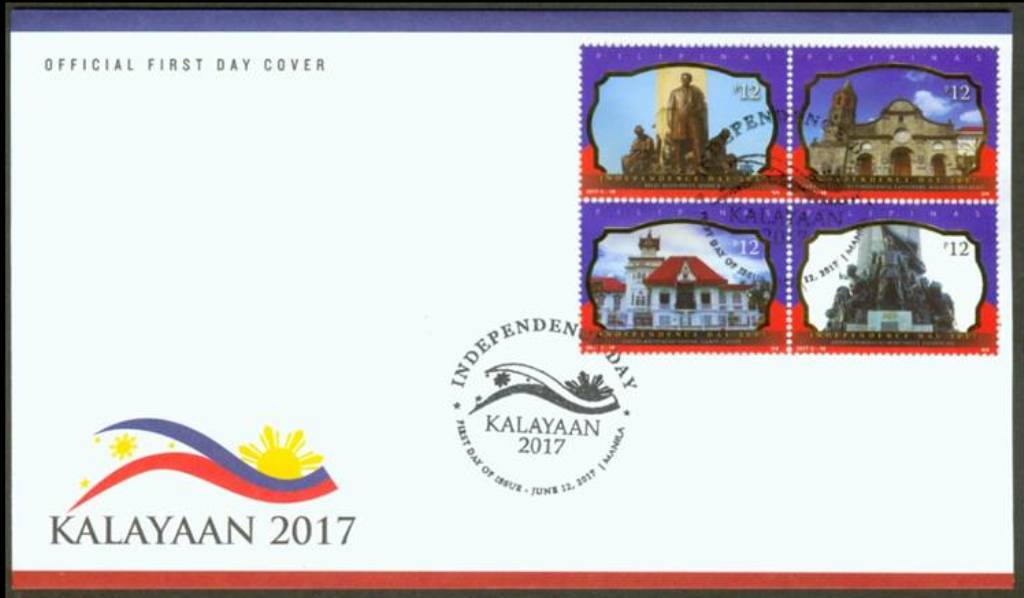2017, June 12. Independence Day
Litho Offset, Amstar Printing Company, Inc., Perf 14; With Gold Foil Stamping
Se-tenant Blocks of 4, Miniature Sheets of 16


Se-tenant Blocks of Four (25,600)
12p Rizal Monument
12p Barasoain Church
12p Aguinaldo Shrine
12p Bonifacio Monument
Miniature Sheets of 16 (6,400)
First Day Covers: Manila
PHILIPPINE INDEPENDENCE DAY
Rizal Monument. The bronze-and-granite Rizal monument is among the most famous sculptural landmarks in Philippines. Located on the monument is not merely the statue of the national hero, but also his remains. On September 28, 1901, the United States Philippine Commission approved Act No. 243, which would erect a monument in Luneta to commemorate the memory of Dr. José Rizal, Philippine patriot, writer and poet. The shrine was finally unveiled on December 30, 1913 during Rizal’s 17th death anniversary. His poem "Mi Ultimo Adios" ("My Last Farewell") is inscribed on the memorial plaque. The site is continuously guarded by ceremonial soldiers of Philippine Marine Corps’ Marine Security and Escort Group.
Barasoain Church. Roman Catholic Church built in 1888 in Malolos, Bulacan. As tensions were brewing between the Filipino revolutionaries and the Americans, the Philippine Revolutionary Government under the leadership of Emilio Aguinaldo moved the capital north from Cavite to Malolos in Bulacan. Plans were made to write a new constitution for the soon to be proclaimed Philippine Republic; Barasoain Church was chosen to be the site of the First Philippine Congress, otherwise known as the Malolos Congress, which convened on September 15, 1898 to draft what would become the Malolos Constitution.
Aguinaldo Shrine. Ancestral home of Emilio Aguinaldo, officially the first President of the Philippines, and the only president of the First Philippine Republic. On June 12, 1898, the independence from Spain was proclaimed from the window of the grand hall. The Declaration of Philippine Independence was read by its author, Ambrosio Rianzares Bautista and ratified by the Malolos Congress on September 21, 1898.
Bonifacio Monument. Located in Grace Park, Caloocan, Bonifacio Monument recalls the Philippine Revolution which was spearheaded by Andrés Bonifacio who urged his men to raise against the colonial rule of Spain. His call to take arms against the Spanish rule was given on 23 August 1896, which is widely known as "Cry of Pugad Lawin." Bonifacio "founded" the Katipunan, or, Kataastaasang Kagalanggalangang Katipunan ng mga Anak ng Bayan ("Highest and Most Respected Society of the Country's Children"). The secret society sought independence from Spain through armed revolt. It was influenced by Freemasonry through its rituals and organization, and several members including Bonifacio were also Freemasons. Bonifacio is often called "The Father of the Philippine Revolution".
-
Monuments
-
Religious/Churches
